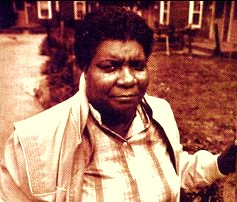Hazel M. Johnson facts for kids
Quick facts for kids
Hazel M. Johnson
|
|
|---|---|
 |
|
| Born | January 25, 1935 New Orleans
|
| Died | January 12, 2011 (aged 75) Chicago
|
| Organization | People for Community Recovery |
| Movement | Environmental justice |
Hazel M. Johnson (born January 25, 1935 – died January 12, 2011) was an important environmental activist from Chicago, Illinois. She is known as the "mother of environmental justice" because she worked hard to make sure everyone had a healthy place to live, no matter where they came from.
Contents
Hazel Johnson's Early Life
Hazel Johnson was born in New Orleans, Louisiana, on January 25, 1935. When she was 12, she became an orphan and went to live with her aunt in Los Angeles. She attended high school there for two years. Later, she returned to New Orleans to live with her grandmother.
In 1955, Hazel and her husband, John Johnson, moved to Woodlawn, Chicago with their two children. Hazel worked many jobs while raising her family. She helped recruit people for a neighborhood group and sorted mail for the U.S. Postal Service.
Fighting for a Healthy Home
In 1962, the Johnsons moved to Altgeld Gardens Homes on the South Side, Chicago. This housing project was built for war veterans. However, it was surrounded by landfills, factories, and sewage plants.
After her husband died from lung cancer in 1969, Hazel noticed her seven children also had many skin and breathing problems. She started to investigate why. Hazel documented the health issues in her community. She wanted to understand how the air and water pollution were affecting people.
The Toxic Donut
What Hazel learned was shocking. She called her neighborhood "The Toxic Donut." This was because it was surrounded by so much pollution. People in Altgeld Gardens were breathing in dangerous fumes from nearby factories. Their homes also had asbestos, a harmful building material. The drinking water was contaminated, too. The community had the highest cancer rate in the city.
Hazel realized the Chicago Housing Authority was not taking care of the buildings. They were also ignoring the environmental dangers. She decided to take action. In 1970, she ran for and was elected to the Altgeld Gardens Local Advisory Council. She served in this role until 1979.
People for Community Recovery
In 1979, Hazel Johnson started her own group called People for Community Recovery (PCR). In 1982, it became a non-profit organization. The group focused on fighting environmental racism. This is when harmful environmental conditions unfairly affect communities of color.
PCR's Achievements
One of PCR's first big successes was getting the city of Chicago to test the drinking water in a nearby area called Maryland Manor. The tests in 1984 showed that the water had toxins, including cyanide. Because of PCR's work, water and sewer lines were brought to the area.
The People for Community Recovery group is still active today. Hazel's daughter, Cheryl, now leads it. The group has done many studies. These studies show that the South Side of Chicago has very high rates of breathing, lung, and skin diseases. They also found high rates of infant deaths and cancer. In 2009, PCR donated their records to the Chicago Public Library. This allows everyone to learn about their important work.
Hazel Johnson's Legacy
Hazel Johnson received the 1992 President's Environment and Conservation Challenge award. This award recognized her important work in environmental justice.
In 2004, a sociologist named David Naguib Pellow praised Hazel Johnson and PCR. He said they made the South Side of Chicago known to activists and lawmakers across the United States. These people were concerned about environmental racism.
Hazel explained her work by saying, "It's good to care about saving rainforests and endangered animals. But those global efforts don't help communities where people of color live."
On January 12, 2011, Hazel Johnson died from heart problems.
Honoring Hazel Johnson
After her death, the Illinois General Assembly honored Hazel Johnson. They named a part of 130th Street in Chicago the "Hazel Johnson EJ Way." EJ stands for Environmental Justice. A ceremony was held on September 15, 2016, to celebrate the street naming.

